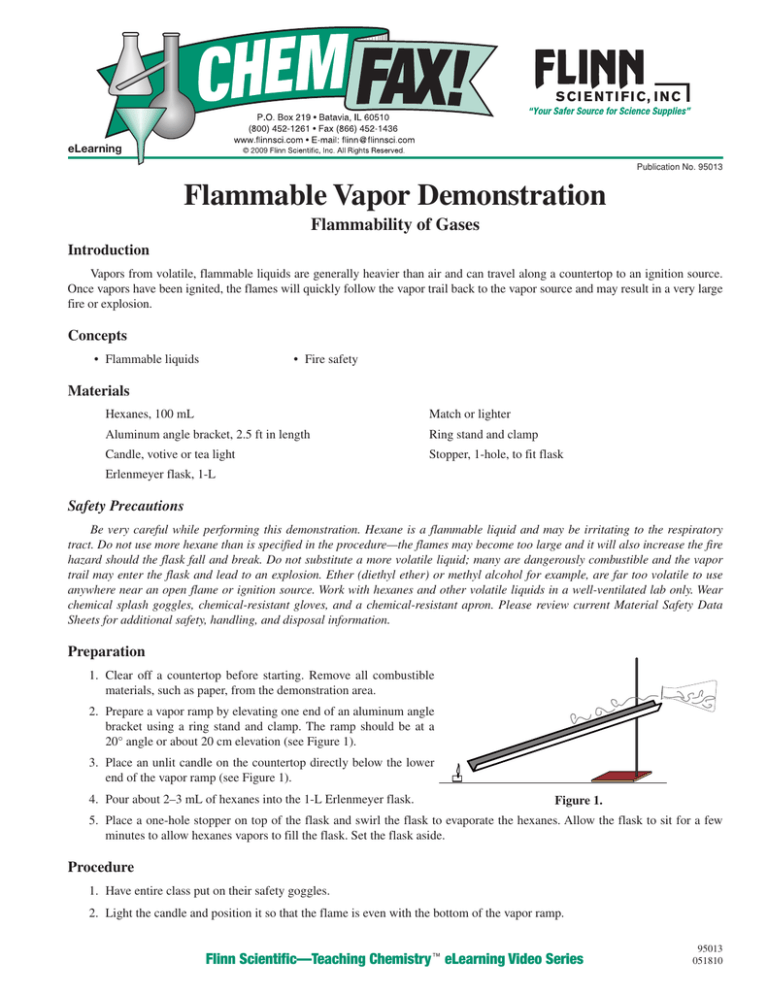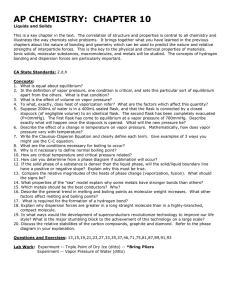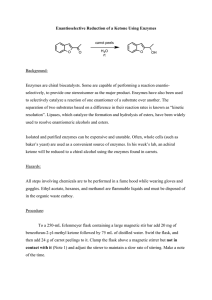
eLearning
2009
Publication No. 95013
Flammable Vapor Demonstration
Flammability of Gases
Introduction
Vapors from volatile, flammable liquids are generally heavier than air and can travel along a countertop to an ignition source.
Once vapors have been ignited, the flames will quickly follow the vapor trail back to the vapor source and may result in a very large
fire or explosion.
Concepts
• Flammable liquids
• Fire safety
Materials
Hexanes, 100 mL
Match or lighter
Aluminum angle bracket, 2.5 ft in length
Ring stand and clamp
Candle, votive or tea light
Stopper, 1-hole, to fit flask
Erlenmeyer flask, 1-L
Safety Precautions
Be very careful while performing this demonstration. Hexane is a flammable liquid and may be irritating to the respiratory
tract. Do not use more hexane than is specified in the procedure—the flames may become too large and it will also increase the fire
hazard should the flask fall and break. Do not substitute a more volatile liquid; many are dangerously combustible and the vapor
trail may enter the flask and lead to an explosion. Ether (diethyl ether) or methyl alcohol for example, are far too volatile to use
anywhere near an open flame or ignition source. Work with hexanes and other volatile liquids in a well-ventilated lab only. Wear
chemical splash goggles, chemical-resistant gloves, and a chemical-resistant apron. Please review current Material Safety Data
Sheets for additional safety, handling, and disposal information.
Preparation
1. Clear off a countertop before starting. Remove all combustible
materials, such as paper, from the demonstration area.
2. Prepare a vapor ramp by elevating one end of an aluminum angle
bracket using a ring stand and clamp. The ramp should be at a
20° angle or about 20 cm elevation (see Figure 1).
3. Place an unlit candle on the countertop directly below the lower
end of the vapor ramp (see Figure 1).
4. Pour about 2–3 mL of hexanes into the 1-L Erlenmeyer flask.
Figure 1.
5. Place a one-hole stopper on top of the flask and swirl the flask to evaporate the hexanes. Allow the flask to sit for a few
minutes to allow hexanes vapors to fill the flask. Set the flask aside.
Procedure
1. Have entire class put on their safety goggles.
2. Light the candle and position it so that the flame is even with the bottom of the vapor ramp.
Flinn Scientific—Teaching Chemistry eLearning Video Series
95013
051810
3. Remove the stopper from the flask containing the hexanes. Gradually pour the hexane vapors down the ramp for about
three seconds. Tip the flask slightly and do not allow any unevaporated liquid hexanes to pour out. Be prepared to have the
fumes catch fire.
4. Nothing will happen for a few seconds—be patient. The vapors will soon ignite and then race up the ramp.
5. After the flames race up the trough, the demo can be repeated.
Disposal
Please consult your current Flinn Scientific Catalog/Reference Manual for general guidelines and specific procedures, and
review all federal, state and local regulations that may apply, before proceeding. Contact a licensed removal company regarding the
hexanes solution according to Flinn Suggested Disposal Method #18a.
Tips
• Aluminum angle brackets may be purchased at home or building supply stores—they are called wall angles and are used
to protect wall corners.
• Hexane, hexanes, and petroleum ether (not ethyl ether) are all similar materials and will work well in the demonstration.
Do not substitute any other flammable liquids for this demonstration. (“Hexanes” denotes a mixture of isomeric hydrocarbons having the formula C6H14.)
• If the ramp cannot be adjusted using a ring stand and clamp, hold the ramp with one hand using an oven glove or a fireresistant welder’s glove. Hold the ramp from beneath, open-side up. Keep fingers and gloves away from any flames.
• Practice this demo beforehand to understand how long to pour the hexanes vapors. The flask should not be near the trough
when the flames ignite. If you are still pouring when the flames start, take the flask away from the top of the vapor ramp to
prevent the fire from going back into it. (If the flame does make it back into the flask, it is OK; it will just burn there for a
while at the mouth of the flask, unable to burn the entire sample due to inadequate oxygen.)
Discussion
Many organic solvents have very low boiling points and hence are highly volatile at ambient temperatures. For example, the
hexanes solution has a boiling point of 68–70 °C (154–158 °F) and a vapor pressure of 150 mm Hg at 25 °C. Most organic compound vapors are also colorless and therefore nearly impossible to see. Hexanes (C6H14) have a molecular weight of 86 g/mol.
This gives hexanes vapors a density of nearly three times that of air (M.W. of oxygen is 32 g/mol). Thus, hexanes vapors (and
most other organic vapors) are heavier than air and will sink in air. Heavier-than-air vapors are also easy to pour.
When the hexanes vapors are poured down the vapor ramp and make their way to the lit candle, all three necessary ingredients for a fire are present: air containing oxygen, hexanes fuel, and a source of ignition or heat. The flame travels back up the
ramp, leaving an impressive trail of fire as it goes.
What makes this an especially valuable demonstration is the safety lesson to be conveyed: Using flammable liquids indoors can
be a fire hazard even if you are nowhere near an open flame. Indeed, as any firefighter can attest to, volatile fumes can travel along
the floor, even down steps, and find an ignition source, such as the pilot light of a furnace or hot water heater or an electric switch.
Outdoors, ignition sources are less common, and winds generally cause the fumes to dissipate and not reach combustible levels.
Connecting to the National Standards
This laboratory activity relates to the following National Science Education Standards (1996):
Unifying Concepts and Processes: Grades K–12
Systems, order, and organization
Evidence, models, and explanation
Content Standards: Grades 5–8
Content Standard B: Physical Science, properties and changes of properties in matter
Content Standard F: Science in Personal and Social Perspectives; natural hazards
Content Standards: Grades 9–12
Content Standard B: Physical Science, structure and properties of matter
Content Standard F: Science in Personal and Social Perspectives; natural and human-induced hazards
–2–
© 2010 Flinn Scientific, Inc. All Rights Reserved.
95013
Answers to Worksheet Questions
1. Draw the set-up for this demonstration. Include an arrow indicating the movement of the flames that were created.
2. What properties do you think allowed the hexanes solution to evaporate so easily? It did not require any heating.
The hexanes mixture probably has a low boiling point that is closer to room temperature than most other liquids, including
water. Because of this, the liquid probably also has the ability to evaporate at lower temperatures than other solutions.
3. Why did the hexane vapors (C6H14) travel down the ramp when they were poured out of the flask, instead of just dispersing into the air? (Hint: Keep in mind that the molecular weight of oxygen is 32 g/mol.)
Hexanes have a higher molecular weight, at 86 g/mol, than oxygen (32 g/mol). Therefore its vapor density is greater, as
well. This forces hexane vapors to sink in air and travel along surfaces rather than rising into the air and dispersing.
4. What does this demonstration teach you about using flammable liquids in the laboratory?
Using flammable liquids such as hexanes is dangerous in the lab for a number of reasons. First of all, many organic flammables have low boiling points and evaporate easily. These vapors can travel all over a lab or even a building. Should
they encounter an ignition source, such as a furnace or an electrical switch, they will light on fire and spread quickly.
References
Becker, R. Twenty Demonstrations Guaranteed to Knock Your Socks Off!, Vol. 2; Flinn Scientific: Batavia, IL, 1997, pp 59–60.
Flinn Scientific—Teaching Chemistry™ eLearning Video Series
A video of the Flammable Vapor Demonstration activity, presented by Irene Cesa, is available in Flammability of Gases, part
of the Flinn Scientific—Teaching Chemistry eLearning Video Series.
Materials for Flammable Vapor Demonstration are available from Flinn Scientific, Inc.
Materials required to perform this activity are available in the Flaming Vapor Ramp—Demonstration Kit available from Flinn
Scientific. Materials may also be purchased separately.
Catalog No.
AP6154
H0046
GP3055
Description
Flaming Vapor Ramp—Demonstration Kit
Hexanes, Reagent, 100 mL
Erlenmeyer Flask, Borosilicate Glass, 1 L
Consult your Flinn Scientific Catalog/Reference Manual for current prices.
–3–
© 2010 Flinn Scientific, Inc. All Rights Reserved.
95013
Flammable Vapor Demonstration Worksheet
Discussion Questions
1. Draw the set-up for this demonstration. Include an arrow indicating the movement of the flames that were created.
2. What properties do you think allowed the hexanes solution to evaporate so easily? It did not require any heating.
3. Why did the hexane vapors (C6H14) travel down the ramp when they were poured out of the flask, instead of just dispersing into the air? (Hint: Keep in mind that the molecular weight of oxygen is 32 g/mole.)
4. What does this demonstration teach you about using flammable liquids in the laboratory?
95013
© 2010 Flinn Scientific, Inc. All Rights Reserved. Reproduction permission is granted only to science teachers who have purchased Flammability of Gases in the Flinn Scientific—Teaching
Chemistry™ eLearning Video Series. No part of this material may be reproduced or transmitted in any form or by any means, electronic or mechanical, including, but not limited to photocopy, recording, or any information storage and retrieval system, without permission in writing from Flinn Scientific, Inc.






